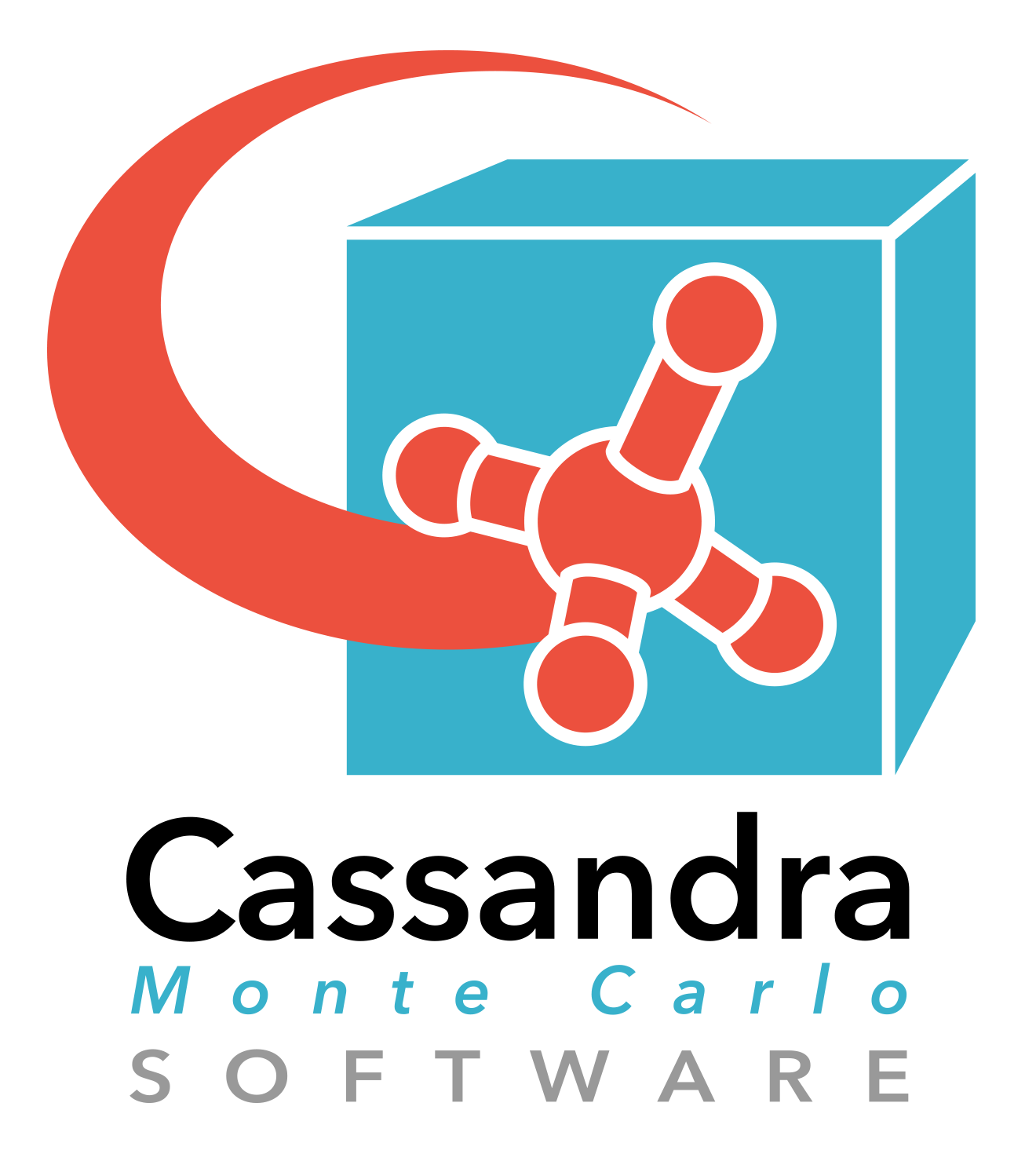
Contents
Overview
Cassandra is an open source Monte Carlo package developed in the Maginn group at the University of Notre Dame to perform atomistic simulations of molecules composed of rings, chains, or both. Cassandra is suited to compute the thermodynamic properties of fluids and phase equilibria. It handles a standard "Class I"-type force field having fixed bond lengths. Cassandra uses OpenMP parallelization and comes with a number of scripts, utilities and examples to help with simulation setup. It is released under the GNU General Public License.
A Python interface to Cassandra is under development as well. Further details are available here.
Features
The following features are supported in version 1.2:
-
Ensembles
- Canonical
- Isothermal-Isobaric
- Grand-canonical
- Constant volume Gibbs
- Constant pressure Gibbs
-
Moves
- Translation
- Rotation
- Box volume
- Molecule regrowth
- Molecule insertion
- Molecule deletion
- Molecule swap
- Dihedral change
- Angle change
- Atom displacement
- Ring flip
-
Potentials
- LJ and Mie
- Fixed bond lengths
- Harmonic and fixed angles
- OPLS, CHARMM and harmonic proper dihedrals
- Harmonic improper dihedrals
- Point partial charges
-
Other
- Cut-off schemes: cut, cut and shift, cut and switch, standard long-tail correction
- Electorstatics: Ewald or damped shifted force methods
Installation
We offer the option to install from source or through conda-forge.
The simplest way to get Cassandra is through conda-forge.
Installation with conda
If you already have conda
installed, you can install Cassandra into a new conda environment
with the following command:
> conda create --name cassandra -c conda-forge cassandra
Once you activate the environment, Cassandra should be accesible on your PATH.
You can test with the following:
> conda activate cassandra
> which cassandra.exe
> which library_setup.py
> which mcfgen.py
If the installation was successful, you should see the location of each of
those files. The conda-forge installation uses gfortran with
OPENMP parallelization. The number of parallel threads can be controlled
by setting the OMP_NUM_THREADS environment variable. For example, in bash:
export OMP_NUM_THREADS=4
Cassandra parallelizes reasonably up to 8-12 threads.
Installation from source
The source code tarball for the latest release is available through our releases page. Alternatively, you can clone the GitHub repository to get the bleeding edge version:
> git clone
https://github.com/MaginnGroup/Cassandra.git
In either case, the /Src/ directory contains the Makefiles that you can use to compile the code.
Makefiles contain the compilation options and set of directives used to automate the build.
At present, Makefiles for the Intel Fortran Compiler, gfortran and
Portland group compiler (PGI) are included in the distribution.
To compile Cassandra, first remove any object files using the 'clean' command
> make clean
The following table provides examples of the commands you need to use to compile the source code as provided:
| Build type | Intel Compiler | GNU Fortran |
|---|---|---|
| Debug | make -f Makefile |
make -f Makefile.gfortran |
| OpenMP | make -f Makefile.intel.openMP |
make -f Makefile.gfortran.openMP |
Each of these commands will produce an executable with the name specified in the field EXEC NAME in the relevant Makefile.
You can take these Makefiles as templates creating your own customized Makefile. Depending on the architecture of the machine you are using, you will need to change compilation options and flags. Note that to change compiler options appropriate for your environment, the F90FLAGS line in the Makefiles can be edited. You can also modify the optimization options to improve the speed of the code or operate in debug mode.
Before running the openMP enabled executable, the environment variable OMP_NUM_THREADS will have to be set to the number of threads you want to run the simulation on. For example, for 12-thread simulation, the following command is used in tcsh:
> setenv OMP_NUM_THREADS 12
or alternatively in bash:
> export OMP_NUM_THREADS=12
Getting Started
/Examples. This directory contains examples of short Cassandra simulations in NVT, NPT, grand canonical and Gibbs ensembles for a number of systems molecules with varying degrees of conformational complexity (LJ particles, branch points, ring moieties) and those requiring computation of electrostatic interactions are included.
/Documentation. Chapter 3 of the documentation provides an overview of the files and workflow to setup a Cassandra simulation. Additionally, the workshop materials contain more examples and slides that have been used for teaching.
Contributing
Depending on whether you are a user or a developer, you can contribute to Cassandra in the following ways:
-
User
-
Developer
- Contribute code or documentation using GitHub pull request workflow. See a primer on Cassandra Software Development on GitHub. See CONTRIBUTING for more details on the contributing process.
- Ask development questions (i.e. you are trying to fix a bug or contribute with a new feature) using Slack.
Citation
J. K. Shah, E. Marin‐Rimoldi, R. G. Mullen, B. P. Keene, S. Khan, A. S. Paluch, N. Rai, L. L. Romanielo, T. W. Rosch, B. Yoo, E. J. Maginn. J. Comput. Chem. 2017, 38, 1727–1739. DOI: 10.1002/jcc.24807



